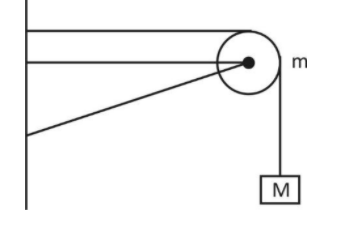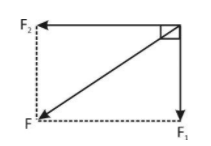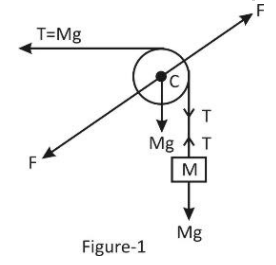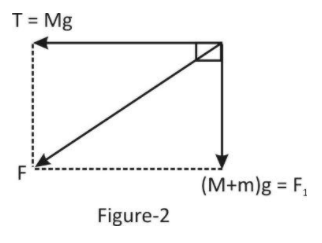
A string of negligible mass going over a clamped pulley of mass m supports a block of mass M as shown in the figure. The force on the pulley by the clamp is given by:
A. $\sqrt 2 Mg$
B. $\sqrt 2 Mg/k$
C. $g\sqrt {{{\left( {M + m} \right)}^2} + {m^2}} $
D. $g\sqrt {{{\left( {M + m} \right)}^2} + {M^2}} $


Answer
578.7k+ views
Hint: When two forces are acting at right angle, then resultant of the force is given by, \[F = \sqrt {{F_1}^2 + {F_2}^2} \]
The normal force always passes through the centre of the disc.
At equilibrium the not force into the system is zero.

Complete step by step solution:
Let tension in the string is T and force applied by pulley by the clamp is F. The free body diagram (FBD) of the system is given below:


The total downward force into the system is ${F_1} = Mg + mg$ or ${F_1} = (M + m)g$ and the total horizontal force working on system is $T = Mg$ (see figure 1 and figure 2)
The force by pulley on clamp and by clamp on pulley will be equal and opposite.
Now, the resultant of vertical and horizontal force will be applied by clamp on pulley.
Now the force on the pulley by the clamp is given by from figure 2,
\[
F = \sqrt {{F_1}^2 + {T^2}} \\
F = \sqrt {{{\left[ {\left( {M + m} \right)g} \right]}^2} + {{\left( {Mg} \right)}^2}} \\
\]
$
= \sqrt {{{\left( {M + m} \right)}^2}{g^2} + {M^2}{g^2}} \\
F = \left[ {\sqrt {{{\left( {M + m} \right)}^2}} + {M^2}} \right]g \\
$
Hence, option (D) is correct.
Note: Note: The tension (T) in string is defined as “the force exerted by a string when it is subjected to pull”. Practically, if a person is holding a block of some weight attached to the one end of a staring then the force experienced by the person is Tension (T).
The normal force always passes through the centre of the disc.
At equilibrium the not force into the system is zero.

Complete step by step solution:
Let tension in the string is T and force applied by pulley by the clamp is F. The free body diagram (FBD) of the system is given below:


The total downward force into the system is ${F_1} = Mg + mg$ or ${F_1} = (M + m)g$ and the total horizontal force working on system is $T = Mg$ (see figure 1 and figure 2)
The force by pulley on clamp and by clamp on pulley will be equal and opposite.
Now, the resultant of vertical and horizontal force will be applied by clamp on pulley.
Now the force on the pulley by the clamp is given by from figure 2,
\[
F = \sqrt {{F_1}^2 + {T^2}} \\
F = \sqrt {{{\left[ {\left( {M + m} \right)g} \right]}^2} + {{\left( {Mg} \right)}^2}} \\
\]
$
= \sqrt {{{\left( {M + m} \right)}^2}{g^2} + {M^2}{g^2}} \\
F = \left[ {\sqrt {{{\left( {M + m} \right)}^2}} + {M^2}} \right]g \\
$
Hence, option (D) is correct.
Note: Note: The tension (T) in string is defined as “the force exerted by a string when it is subjected to pull”. Practically, if a person is holding a block of some weight attached to the one end of a staring then the force experienced by the person is Tension (T).
Recently Updated Pages
Master Class 11 Economics: Engaging Questions & Answers for Success

Master Class 11 English: Engaging Questions & Answers for Success

Master Class 11 Social Science: Engaging Questions & Answers for Success

Master Class 11 Biology: Engaging Questions & Answers for Success

Class 11 Question and Answer - Your Ultimate Solutions Guide

Master Class 11 Business Studies: Engaging Questions & Answers for Success

Trending doubts
What is meant by exothermic and endothermic reactions class 11 chemistry CBSE

1 Quintal is equal to a 110 kg b 10 kg c 100kg d 1000 class 11 physics CBSE

What is periodicity class 11 chemistry CBSE

Explain zero factorial class 11 maths CBSE

What is a periderm How does periderm formation take class 11 biology CBSE

What are porins class 11 biology CBSE




